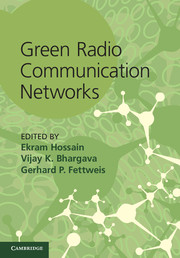Book contents
- Frontmatter
- Contents
- List of contributors
- Preface
- Part I Communication architectures and models for green radio networks
- Part II Physical communications techniques for green radio networks
- 5 Green modulation and coding schemes in energy-constrained wireless networks
- 6 Cooperative techniques for energy-efficient wireless communications
- 7 Effect of cooperation and network coding on energy efficiency of wireless transmissions
- Part III Base station power-management techniques for green radio networks
- Part IV Wireless access techniques for green radio networks
- Part V Green radio test-bed, experimental results, and standardization activities
- Index
- References
5 - Green modulation and coding schemes in energy-constrained wireless networks
from Part II - Physical communications techniques for green radio networks
Published online by Cambridge University Press: 05 August 2012
- Frontmatter
- Contents
- List of contributors
- Preface
- Part I Communication architectures and models for green radio networks
- Part II Physical communications techniques for green radio networks
- 5 Green modulation and coding schemes in energy-constrained wireless networks
- 6 Cooperative techniques for energy-efficient wireless communications
- 7 Effect of cooperation and network coding on energy efficiency of wireless transmissions
- Part III Base station power-management techniques for green radio networks
- Part IV Wireless access techniques for green radio networks
- Part V Green radio test-bed, experimental results, and standardization activities
- Index
- References
Summary
Introduction
The past decade has witnessed many significant advances in the physical layer of wireless communication systems in both theory and implementation. Traditionally, the design of existing cellular networks has focused on increasing the spectral efficiency, throughput, and transmission reliability, while minimizing the latency. The recent research focus has also included studying the energy efficiency in next generation wireless networks; associated with this shift is a new point of view that wireless communications are becoming ubiquitous and that the energy consumption of embedded devices is gradually increasing. Of interest is the next generation of mobile technologies, where the energy resources are scarce and have to be conserved, in particular when the replenishment of the energy resource is not easy. On the other hand, in indoor or short-range communications such as pico-cellular networks and femtocells, or in dense wireless networks when a large number of mobile nodes is deployed over a region, the circuit energy-consumption is comparable to or even dominates the transmission energy due to the short distance between nodes. Thus, minimizing the total energy-consumption in both circuits and signal transmission compared to the current level should be considered primarily as an important requirement in the different layer design of future wireless networks. These requirements and realizations have led to a push towards green wireless communications and have created inter-disciplinary research challenges in hardware and protocols in different layers of the wireless network.
Towards green communication radios, the standardization processes for future wireless systems should target power control on circuit components as well as powermanagement algorithms for mobile nodes with sleep-mode processes, where the nodes only transmit a finite number of packets in a duty-cycling fashion.
Information
- Type
- Chapter
- Information
- Green Radio Communication Networks , pp. 99 - 124Publisher: Cambridge University PressPrint publication year: 2012
References
Accessibility standard: Unknown
Why this information is here
This section outlines the accessibility features of this content - including support for screen readers, full keyboard navigation and high-contrast display options. This may not be relevant for you.Accessibility Information
- 1
- Cited by
